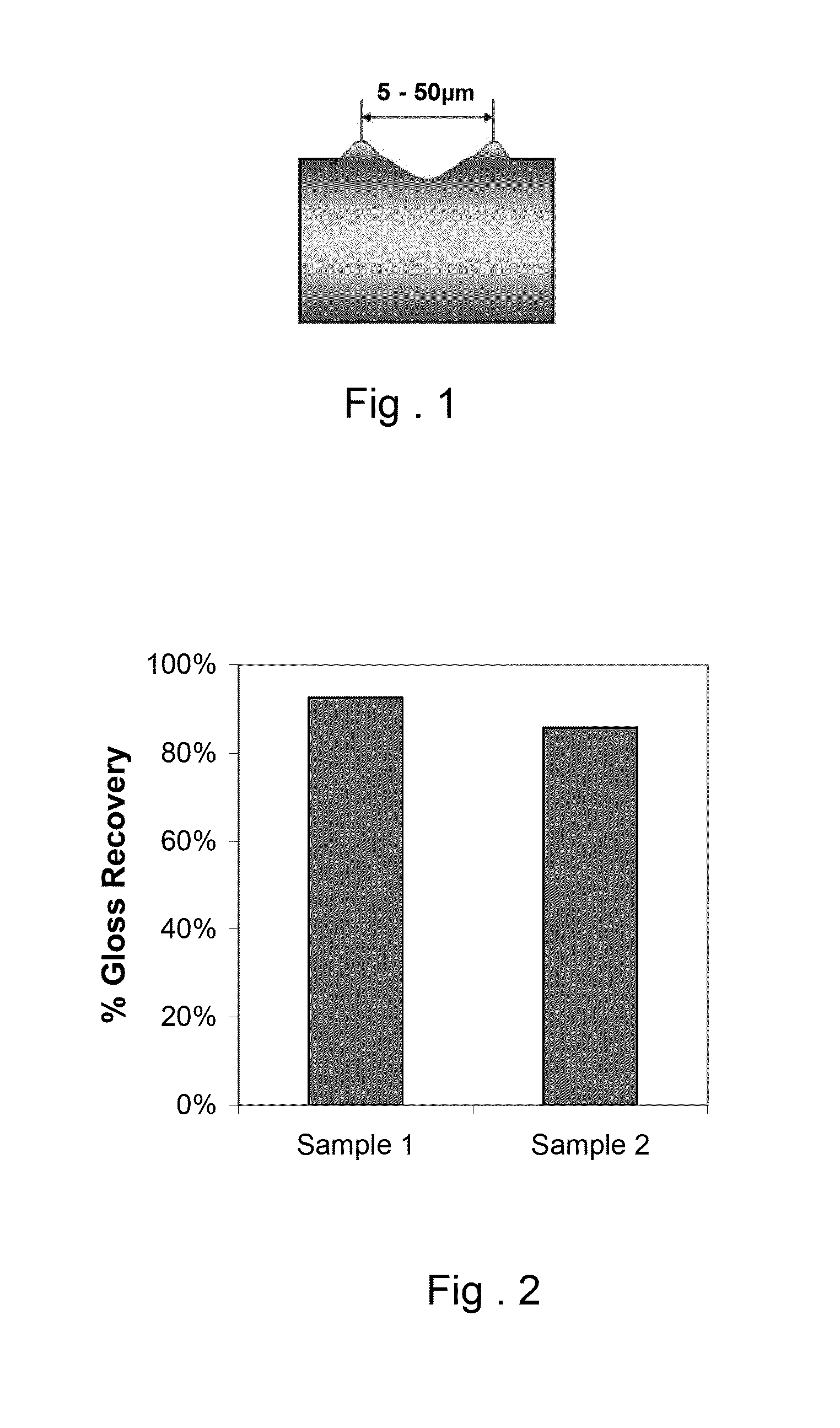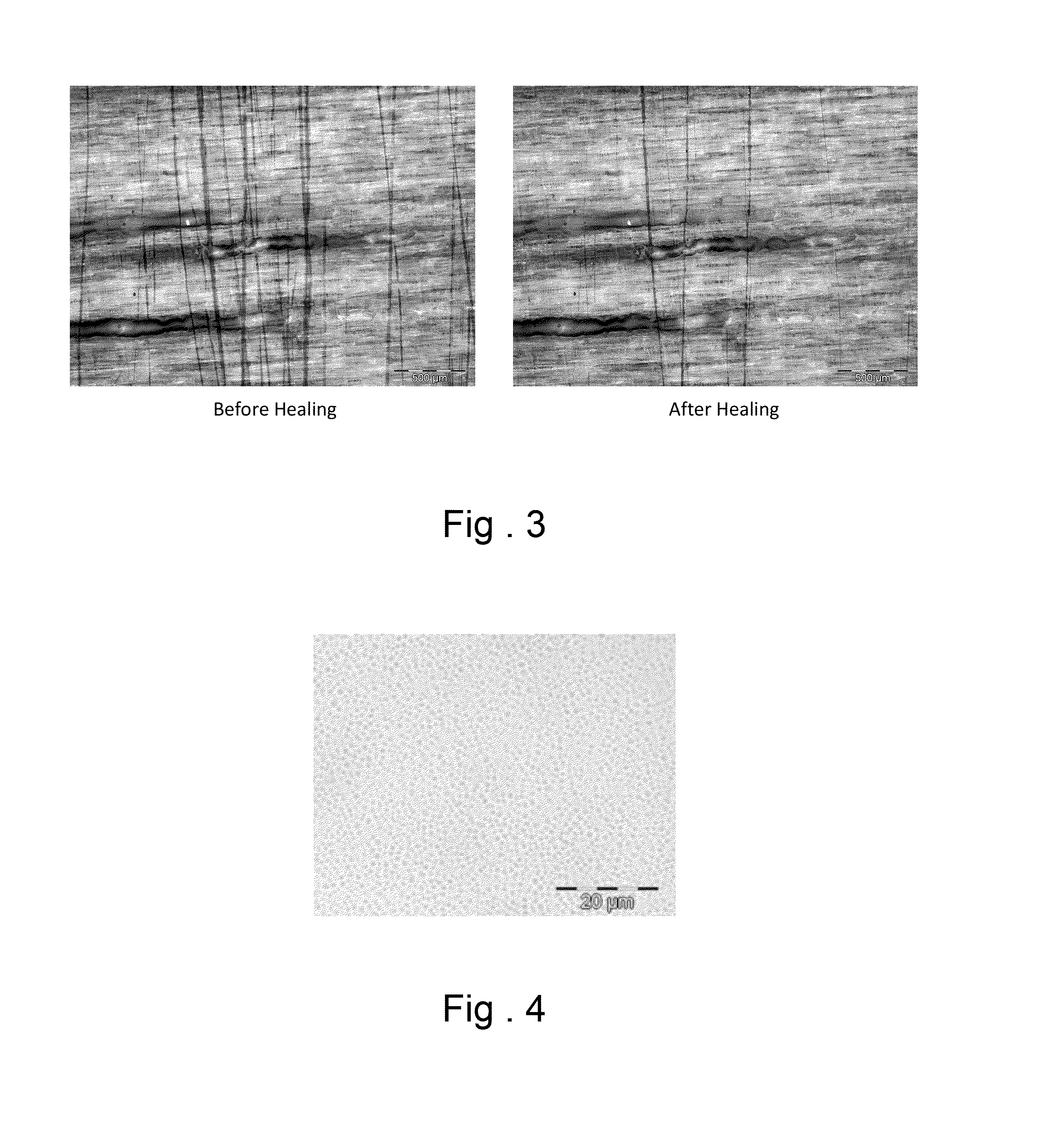Self-healing polymer nanocomposite coatings for use on surfaces made of wood
a technology of polymer nanocomposite and surface, which is applied in the direction of coatings, polyurea/polyurethane coatings, etc., can solve the problems of affecting the mechanical properties of the material, affecting the performance of the material, so as to reduce the viscosity of the pcl loaded, prevent the formation of hydrogen bonding, and reduce the reaction rate with water
- Summary
- Abstract
- Description
- Claims
- Application Information
AI Technical Summary
Benefits of technology
Problems solved by technology
Method used
Image
Examples
example 1
Preparation of Solvent Borne PU / PCL Blend
[0041]Polyurethane material was formulated using commercial saturated polyester polyol and polyisocyanate. Desmophen R 221 75 from Bayer Material Science was used as the saturated polyester polyol with an average equivalent weight of 522. Desmodur N 3390A BA / SN from Bayer Material Science was used as the aliphatic polyisocyanate with an average equivalent weight of 214. Polycaprolactone (PCL) (MW=43,000-50,000 g / mol) was purchased from Polysciences and used as-received.
[0042]PCL was first dissolved in a mixed solvent (90% butyl acetate, 10% tetrahydrofuron [THF]). The PCL solution was then mixed with the polyol, resulting in a transparent solution, before being combined with polyisocyanate. After thorough mixing and degassing, the solution was cast on a wooden substrate and baked at elevated temperature to cure the polyurethane. Procedures for preparing PU / PCL blends containing 15% PCL, which are suitable for wood clear coating, are described...
example 2
Preparation of a Low VOC PU / PCL Blend
[0044]A low VOC (volatile organic compound) (<150 g / L VOC), solvent borne coating formulation was prepared as follows. Zero VOC thinner was first prepared by combining methyl acetate and parachlorobenzotrifluoride (PCBTF) in a 1:1 ratio by mass. In a 4 oz wide mouth jar, 2.13 g of PCL was combined with 2.13 g of THF and 25.0 g of zero VOC thinner. The PCL was allowed to dissolve with the aid of an ultrasonic bath. 9.53 g of Desmophen R 221 75 was then added and mixed with a magnetic stir bar to obtain a transparent solution. Finally, 3.93 g of Desmodur N 3390A and 0.26 g of a 10% BYK-301 surfactant solution in butyl acetate were added. The solution was mechanically stirred for 5 minutes before being applied to wood substrates.
example 3
Preparation of Solvent Borne PU / Nanoparticle / PCL Composite
[0045]Due to the inherent softness of the PCL phase, significant reductions in film hardness were observed for the composite coatings. To address this, nanoparticles were incorporated to reinforce the PCL phase. The nanoparticles can be but not limited to the following: an organo-modified clay, metal oxide, organo-modified metal oxide, and carbon nanotubes. As an example, organically modified aluminum oxide was prepared by a 110° C. reflux reaction of alumina nanoparticles (NanoTek, Nanophase, Inc.) with an aminosilane under inert gas. These nanoparticles were then dispersed in anhydrous butyl acetate by high shear mixing. Next, a nanoparticle / PCL solvent dispersion was prepared in a glass jar by first combining PCL and butyl acetate, then adding the nanoparticle dispersion and sonicating for several minutes, followed by addition of THF. The jar was closed tightly and tape-sealed, then sonicated for 2-3 hours in warm water un...
PUM
| Property | Measurement | Unit |
|---|---|---|
| size | aaaaa | aaaaa |
| size | aaaaa | aaaaa |
| temperature | aaaaa | aaaaa |
Abstract
Description
Claims
Application Information
 Login to View More
Login to View More - R&D
- Intellectual Property
- Life Sciences
- Materials
- Tech Scout
- Unparalleled Data Quality
- Higher Quality Content
- 60% Fewer Hallucinations
Browse by: Latest US Patents, China's latest patents, Technical Efficacy Thesaurus, Application Domain, Technology Topic, Popular Technical Reports.
© 2025 PatSnap. All rights reserved.Legal|Privacy policy|Modern Slavery Act Transparency Statement|Sitemap|About US| Contact US: help@patsnap.com



